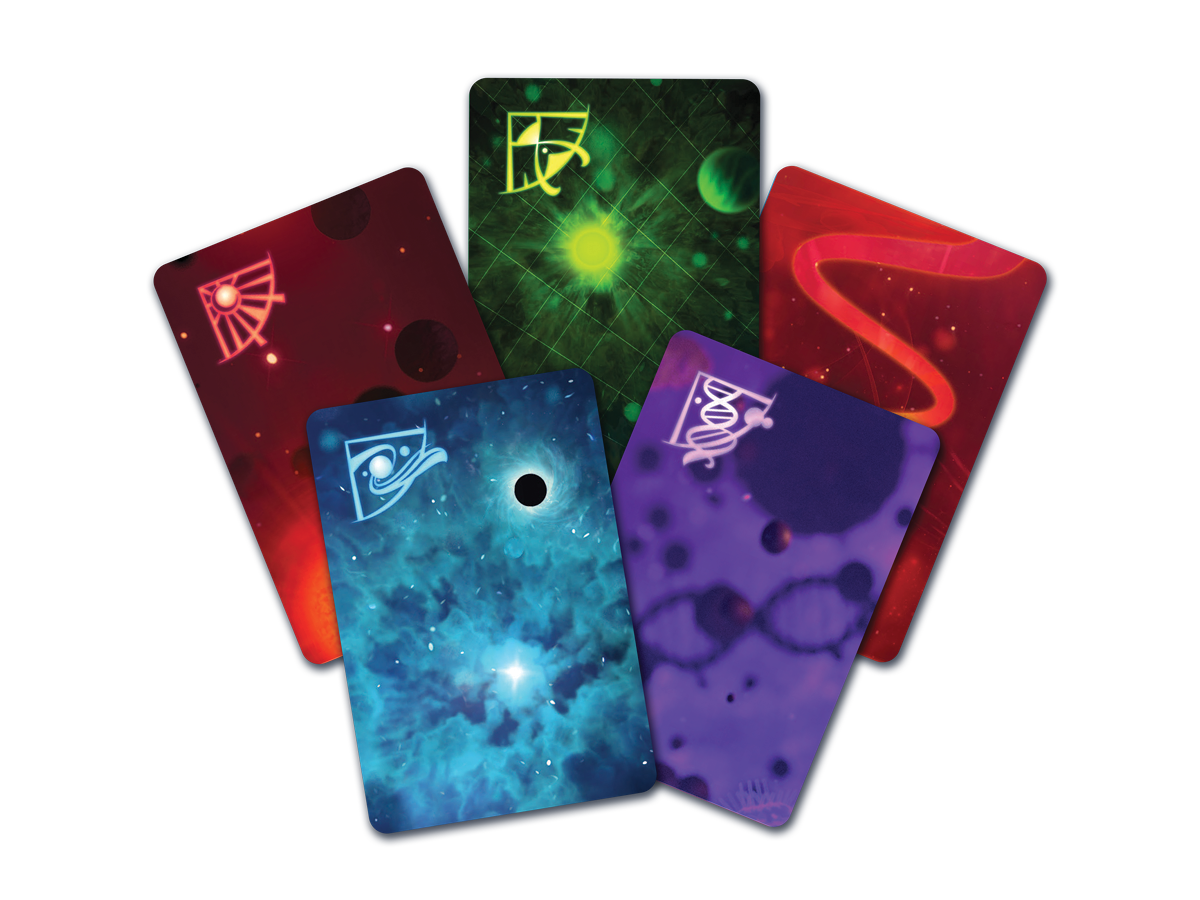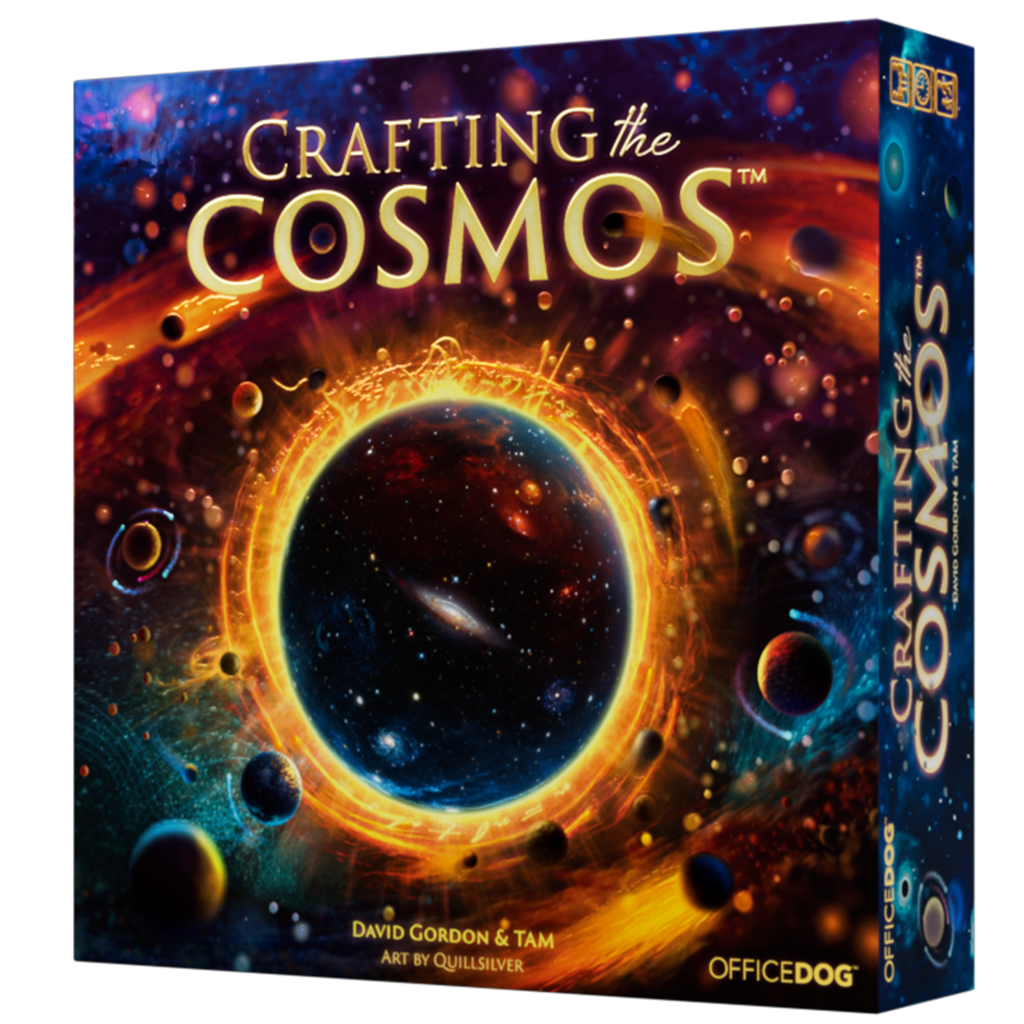
We have absolutely loved working with David Gordon and TAM on Crafting the Cosmos and are excited to finally get to share it will all of you! In our excitement, David and TAM agreed to dive a bit into their experience designing both Crafting the Cosmos and in general. If you’re a fan of the title or an up-and-coming designer yourself, we think you’ll really enjoy what they have to say:
Give us a peek into David Gordon and TAM lore! Where are you each from and how did you start designing games together?
TAM first experienced board game design in a class project in the 4th grade, which led to making games to play with his friends and family in Burma, and a life-long passion of creating analog and digital games. David is from New York City and started designing games in late 2018. David had the great fortune to meet Gil Hova in early 2019. Gil was very open and welcoming to this stranger and invited him to a NYC designer play testing group that meets twice a week in Manhattan. The first time David went, he met TAM, who was also super supportive and encouraging. The NYC group played a key role in David’s education as a game designer.
David and TAM developed a friendship and began co-designing in 2020. They have worked on over 25 games together and have been incredibly fortunate to sign over ten, six of which are expected to be released over the next year. Recently, along with Ammon Anderson (Gnome Hollow) and Greg May (Hex & Co Board Game cafes), they formed UP Games, a small publishing company that is releasing its first game, Floristry, designed by David and TAM, in the spring of 2025.



Much like the cosmos themselves, this game took a while to reach what we see today. What’s the biggest difference between the original design and what’s now in production?
On the way home from the Unpub convention on May 23, 2022, as we always do on road trips to conventions, we brainstormed ideas for a game in which you build something beautiful over the course of the game, so that when you’re done, you look back and can appreciate your accomplishment. David had been thinking about a physics game on a grand scale, where you could change the very building blocks of the universe, such as the gravitational constant, the speed of light, and the elasticity of time. After some discussion about how beautiful nebulae are, the concept of each player being an artisanal architect of the universe, and on this day competing to build a galaxy filled with beautiful, colorful nebulae, was born.
The initial core loop concept was turn-based and primarily focused on forming nebulae for points. The mostly empty galaxies would all start close to each other in the center of the board, and after each round, they would move outward, away from the center, in different directions, modeling the expansion of the universe. Available stars would be rich in Hydrogen (the most common), Helium, Cosmic Dust (later became Carbon), and Plasma (later became Oxygen), all building blocks of young nebulae. The turns would be simple – take a star and build a nebula if you can. Players would be able to adjust 3 different Universal Controls: speed of light, strength of gravity, and speed of time, all to different effects.
So lots has evolved, but much has actually stuck around since the beginning!
When envisioning Crafting the Cosmos on the gaming table, what type of players do you imagine?
We thought about Wingspan quite a bit during the initial brainstorm and throughout the design process. Wingspan has a large audience who are not gamers first (they’re birders), who are drawn in for the theme but find they enjoy the game. We had a similar idea that fans of astronomy might be attracted to our concept but then like our game. So we always wanted to keep the game from being too heavy. We tried to make it accessible, while making sure that fans of medium weight strategy games would find depth and want to play it repeatedly.


Crafting the Cosmos utilizes some popular game mechanisms, but the center console is so unique! Can you tell us a bit about what inspired this design mechanically?
The initial inspiration, as mentioned above, involved modifying “universal controls” that would apply to the game conditions, such as the elasticity of time having a concrete effect on the length of the game, and were core concepts that we built around.
The idea of incorporating the conservation of energy was a key design decision right from the start. We wanted to have a system where shifting energy between the different consoles would have a global impact on the game.
Is there anything you’d like to share with up-and-coming designers?
Some of the most important things David did early on in his journey as a game designer were finding a designer play test group, testing and iterating frequently and on a regular basis, and developing relationships with designers and publishers. He can’t emphasize how much each of those things helped him, and they all continue to be very important.
We also often recommend to up-and-coming designers that they should design because they love the process – they love trying new ideas and seeing them succeed or fail (surprisingly sometimes equally interesting!), they love getting feedback, even if it’s super hard to take sometimes, and making revisions – they love the hope that each iteration brings, and they love seeing people find joy while doing something you created. If you love the process, if you’re process-oriented, you will always be successful, and if you get results, from ending up with a really good game to getting something signed or published, that’s a bonus.
We also find collaborating to be hugely rewarding and productive. Finding the right design partner is crucial to making it work, but there are lots of benefits to co-designing. We’ve been lucky that we complement each other well; in skills, temperament, and commitment, but we each have had wonderful experiences co-designing with other partners (including Jonathan Gilmour-Long, Danielle Reynolds, Christopher Ryan Chan, Gil Hova, and several others), both separately and together as triple co-designs. We’re so all-in on co-designing that we’ve given several panels at conventions on the topic of why co-designing is so beneficial.




Any cool projects you want to tease to our friends reading?
Absolutely! Between the two of us, we have 9-10 games expected to release over the next 12-15 months.
We are thrilled to see our game Monkey Palace, published by Dotted Games/Asmodee and LEGO, released at Essen in October 2024! That project has been just amazing to work on, and we couldn’t be more happy with how it came out. You can find more about that here, including several video overviews and reviews.
As mentioned before, we are super excited about the release of Floristry from our company UP Games! You should be able to find it in large retail stores throughout the US and Canada (we can’t say which ones quite yet). It’s a 2-player game with a dutch auction, and you can see a little review of it here and find more info here.
David has a game called Making Monsters, co-designed with Jonathan Gilmour-Long and published by Astoria Games, going to crowdfunding potentially this fall. It’s a gateway bag-builder with some pretty striking art that you can see here.
Also, we co-designed a game with Chris Chan called Push Push Penguin, published by Wacky Wizard, that is coming out in early 2025. It’s a super family-friendly game that we are very excited about. The publisher is planning to announce the release soon.
David also has a very large release coming out in the new year that he can’t talk about quite yet 🙂, and TAM has a co-design with Danielle Reynolds with CMYK that they’re very excited about.
TAM is also passionate about designing games that have an educational element — a topic he spends lots of time thinking about.
Thanks to both David and TAM for taking the time to chat with us, and thank you, reader, for taking the time hear what they had to say. You’ll be able to pick up your own copy at game stores around the world in March 2025. We hope you have a stellar time crafting your cosmos!


